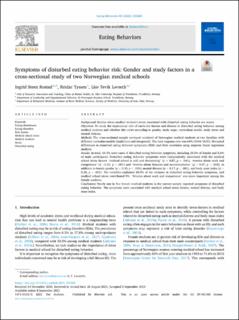| dc.description.abstract | Objectives: To study the explanatory role of curricular factors and distress in disturbed eating behavior among medical students and whether this varies according to gender, study stage, curriculum model, study stress and mental distress. Methods: The cross-sectional sample surveyed consisted of Norwegian medical students at two faculties with different curricular models (traditional and integrated). The total response rate was 64% (1044/1635). We tested differences in disturbed eating behavior symptoms (EDS) and their correlates using stepwise linear regression analysis. Results: In total, 18.3% were cases of disturbed eating behavior symptoms, including 23.5% of female and 5.6% of male participants. Disturbed eating behavior symptoms were independently associated with the medical school stress factors “medical school is cold and threatening” (β = 0.07, p = .041), “worries about work and competence” (β =0.15, p < .001) and “worries about finances and accommodation” (β = 0.07, p = .018), in addition to female gender (β = 0.30, p < .001), mental distress (β = 0.17, p < .001), and body mass index (β = 0.28, p < .001). The variables explained 28.9% of the variance in disturbed eating behavior symptoms, and medical school stress contributed 9%. “Worries about work and competence” was more important among the female students. Conclusions: Nearly one in five female medical students in the current sample reported symptoms of disturbed eating behavior. The symptoms were associated with medical school stress factors, mental distress, and body mass index. | en_US |

